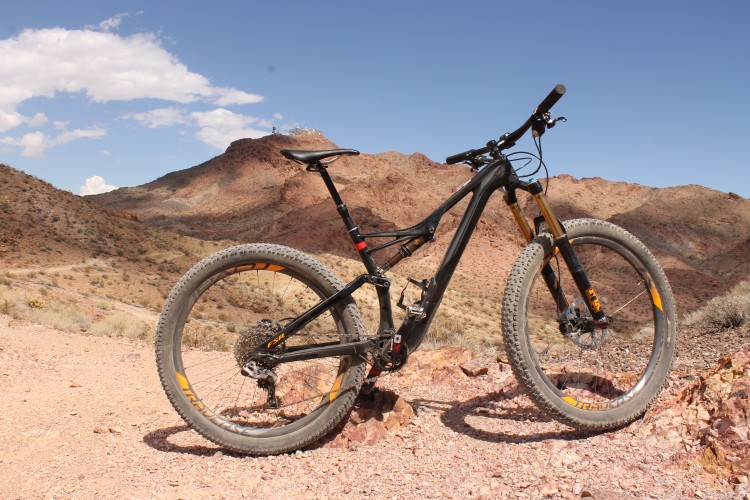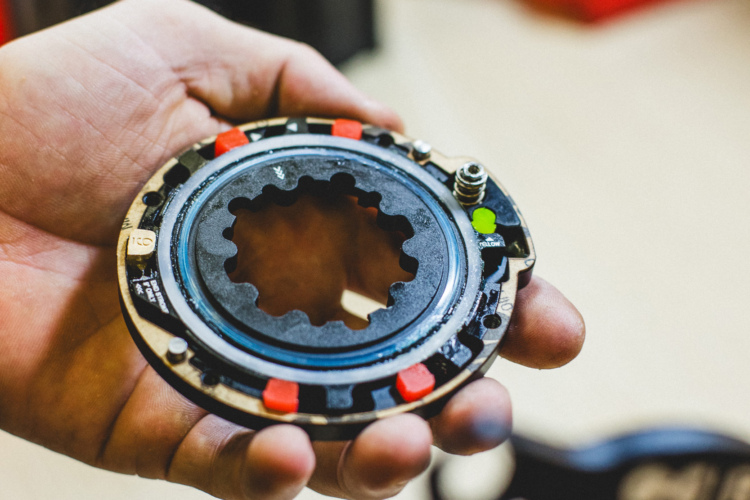
The only constant in life is change, and mountain bike geometry is constantly changing. Yep, things are still getting lower to the ground, longer from wheel to wheel, and pushed back even slacker.
In 2016, when Aaron Chamberlain took a look at the numbers, he categorized 27.5-inch trail bikes as having rear travel between 120mm and 150mm, and 29ers sporting between 120mm and 140mm of rear travel.
Those numbers are still in range for this analysis, but probably not for long. On some of these same bikes, we’ve seen big increases in travel, much slacker angles, and 27.5-inch models changed completely to 29ers, or at least adding in the bigger wheel size as an option.
Let’s talk briefly again about what some of these measurements mean and then look at how things have changed over the past two seasons.

Head tube angle: The angle of the head tube relative to the ground. A steeper head angle keeps your weight more forward which helps with climbing. It also responds to steering input more quickly. A slack head angle will push the rider’s weight back more, adding confidence on steeper downhill sections of trail, while slowing steering input.
Top tube length: The horizontal distance, measured parallel to the ground, between the center of the head tube and where it intersects the seat tube or seat post. As you go up in frame size, this distance will get longer.
Seat tube angle: The angle of the seat tube relative to the ground. More brands are steepening the seat angle to keep the rider over the center of the bike while pedaling.
Reach: The horizontal distance between the center of the head tube and a perpendicular line drawn through the center of the bottom bracket. Reach has mostly been getting longer on updated models.
Stack: The vertical distance between the center of the bottom bracket and the top of the head tube. This may impact the height of the handlebars.
Chainstay length: Measured from the center of the bottom bracket to the rear axle. A shorter chainstay helps with snappy cornering and wheelies. A longer chainstay helps keep the bike more stable.
Bottom bracket (BB) height: The distance from the ground to the center of the bottom bracket. A low BB helps with cornering and keeps center of gravity low, but can mean more pedal strikes.
Wheelbase: The distance from rear to front axle. A longer wheelbase generally means more stability at high speeds, and a shorter one usually results in a more maneuverable bike.
Here’s a look at where the numbers have gone since the end of 2016, and what that means.
The numbers
2016 27.5-inch trail bike geometry

In 2016, the 27.5-inch trail bikes we looked at (all size large) had an average of 142mm of travel up front, 135mm of rear travel, a 67-degree head angle, 74-degree seat able, and the average chainstay length was 429mm.
The average effective top tube length was 622mm, reach was 452mm, stack was 604mm, BB height was 338mm and the average wheelbase for a 27.5-inch mountain bike was 1,174mm.
Have things really changed all that much? Let’s look.
2018/2019 27.5-inch trail bike geometry

The averages for our updated models are 144mm of fork travel, 140mm of rear travel, a 66.5-degree head angle, a 74.6-degree seat angle, 428mm chainstays, and an 1,195mm wheelbase.
Effective top tube length for a large is 623mm, reach is 458mm, stack is 608mm, and BB height is 339mm.
What does it all mean?
It means that things have indeed continued to go slacker and quite a bit longer, but not lower.
The average front travel on these mountain bikes increased by only 2mm, but the rear grew by 5mm. The head angle slackened by a half-degree, the seat tube steepened by more than a half-degree, and the average reach grew by 6mm.
The average wheel base grew by close to an inch. This is certainly the most impacted area of geometry. The bottom bracket height moved up a millimeter, and the chainstay length shortened by a millimeter.
This could suggest that bottom bracket heights have gone as low as they can go, and making them lower isn’t going to help the ride. Or, it could be that with increased travel, bottom brackets are being pushed back up, and may slowly come back down again.
29-inch trail bike geometry

In 2016 when we last looked at 29er trail bikes, the wheel size was picking up momentum. It had broken barriers with skeptical consumers and mostly proved itself.
Average fork travel was 134mm and frame travel was 123mm. The average head angle was 68-degrees and seat tube angle was 74-degrees. The average chainstay length was 437mm, and reach in a size large was 446mm. Bottom bracket height was 335mm and the wheelbase average was 1,176mm.
Unfortunately this isn’t going to be a perfect comparison. The majority of the 29ers we looked at last time have not been updated, and we have a 27.5-inch bike that joined the club — the new Giant Trance. But, the mountain bikes that have been updated will give us a general idea of where geometry is heading for the 29-inch trail bike, and things look to be changing dramatically.

The average fork travel is 138mm, rear travel is 127mm, head angle is 66.4-degrees, and seat angle is 74.6-degrees.
The reach is 440mm, chainstay length is 433mm, bottom bracket height 342mm, and the wheelbase is a long, 1,202mm.
What does it all mean?
The average fork and frame travel increased by 4mm, head angles have averaged over a degree and a half slacker, and the seat tube is more than a half-degree steeper.
Average reach has increased by 14mm, chainstay length was cut by 4mm, and the average wheelbase has increased by over an inch. Bottom bracket height has also not gotten lower for the big wheels and has actually moved up by 7mm, perhaps due to longer travel amounts.
Regular Singletracks readers have probably noticed a swath of long-travel 29ers being released lately. It seems that manufacturers are really nailing down the geometry on these bikes to a T.
An analysis of both wheel sizes
The trail bike category in general is getting more travel. Obviously, right? I’d say this is an indication of good, progressive suspension design, that allows trail bikes to stay high in their travel when climbing, while still offering usable travel for descending.


The real shocker is how quickly average head and seat angles are changing. While 27.5-inch bikes saw head angles slackened by a half-degree, the 29ers changed by more than a degree and a half based off the samples we included. These bikes are edging much closer to the 66-degree mark.
Seat angles are also getting much steeper to make for a suitable climbing position. In both wheel sizes the averages changed from 74-degrees to 74.6-degrees.
While chainstay length didn’t change much for 27.5 bikes, 29ers are seeing shorter chainstays, by 4mm on average. Engineers are finding out what’s really possible for 29ers.
Wheel sizes are becoming a matter of preference more than ever and are not being defined by their capabilities anymore. Now, multiple brands are producing the same model in both wheel sizes.
When 29ers were re-introduced to the mountain bike industry, it was as a more cross-country friendly bike, maybe because designers couldn’t nail down the right geometry for confident descending.
That’s obviously changed, as lately multiple downhill bikes with 29-inch wheels have been released and raced. The big wheels are intended for speed and rollover, while 27.5-inch wheels are regarded as the more fun and nimble wheel size.
Funny, I remember the same thing happening with 27.5-inch and 26-inch wheels not too long ago.
In another two years, maybe we’ll look at geometry again to see how things have changed and if bikes are still getting lower, longer, and slacker… or longer and slacker… or maybe just slacker. Hopefully, we’ll still have two wheel sizes to choose from.






















19 Comments
Aug 23, 2018
I'd like to try one of the new 29ers, but it's hard to imagine it would be better overall than my current setup for the trails around here. Either way, it's great to see brands across the spectrum getting specs dialed in. It's a win for us all.
Aug 23, 2018
Now that I’ve gotten used to it, I can ride my jeffsy on Bikepacking tous and lift service downhill runs, And enjoy it to the fullest.
Nov 22, 2019
Aug 23, 2018
Aug 27, 2018
Don’t get me wrong, modern geometry is fun when things speed-up and modern trail bikes are more capable descenders than DH bikes were in the early 2000’s. It just seems really unforgiving of riders who don’t have their climbing fundamentals dialed.
It could also mean that the awesomeness of new bikes has led to a lot of growth in the sport. In which case, everyone’s a beginner at some point and disregard everything I said...
Nov 1, 2018
Nov 9, 2018
Aug 23, 2018
Oct 30, 2019
Aug 23, 2018
Aug 23, 2018
Aug 23, 2018
I read that article, and I get it. But since I'm currently new bike shopping, I'm learning just how difficult it is to get proper test rides in.
Some shops have rentals/demo fleets, but only in the cheapest version of the bike. For many models, it's difficult to get a test ride at all. The shops can order you anything, but you may not be able to test it first.
Considering I live in Colorado, I imagine it's even harder elsewhere. Consumer direct -- well, what do you have but geometry tables? Reviews seem to be overwhelmingly positive for everything, i.e. not very useful.
Aug 23, 2018
How soon is soon? :) I look forward to reading it.
Aug 23, 2018
Aug 27, 2018
The two stats that jumped out at me were the change in HTA and the "massive" shortening of the chainstays.
I'm all for slacker angles/more travel, but I wonder what the driving force behind the shorter CSs was. It could have been engineers were finally figuring it out, or maybe it was the industry mostly ditching the front derailleur. I think SRAM declared the FD dead after the 2016 models were released.
Aug 28, 2018
Got it, thanks for the clarification!
Aug 28, 2018
I think by making the STA steeper, the rider is moved forward allowing the other changes in geometry to take place to lengthen the wheelbase. At least that's how I visualize it.
Aug 28, 2018
Shorter chainstays tends to make a bike feel more playful and easier to manual. My point was I wonder what was more of a factor in being able to shorten the chainstays: the fact that the engineers finally figured out some voodoo magic or the fact that the FD is basically a thing of the past now. My money is the on the FD no longer being a concern when it comes to designing bikes.
Aug 27, 2018